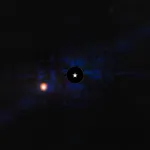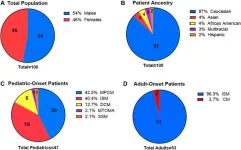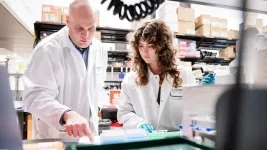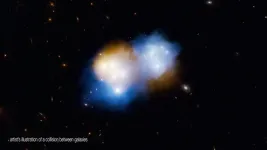(Press-News.org) New research led by the University of East Anglia (UEA) and Plymouth Marine Laboratory (PML) has found that the Southern Ocean absorbs more carbon dioxide (CO2) than previously thought.
Using direct measurements of CO2 exchange, or fluxes, between the air and sea, the scientists found the ocean around Antarctica absorbs 25% more CO2 than previous indirect estimates based on shipboard data have suggested.
The Southern Ocean plays a major role in absorbing CO2 emitted by human activities, a process vital for controlling the Earth's climate. However, there are big uncertainties in the magnitude and variability in this flux.
Until now it has been estimated using shipboard measurements, such as those collected for the Surface Ocean CO2 Atlas (SOCAT) from research ships and sail drones, data from profiling floats deployed in the ocean, and global ocean biogeochemistry models. These different approaches have produced large variations in estimates.
This new study used a novel technique called eddy covariance - with flux systems mounted on ships’ foremasts - to directly measure air-sea CO2 fluxes during seven research cruises in the region.
The results - published in the journal Science Advances - show the summer Southern Ocean is likely to be a strong CO2 sink, challenging the much weaker estimates based on float data and model simulations, which the authors say “substantially underestimate” the observed CO2 uptake.
The authors argue this difference can be explained by considering temperature variations in the upper ocean and a limited resolution, for example averaging over a too-long time scale or sampling over a too-large interval, adding that current models and float data do not account for small, intense CO2 uptake events.
Lead author Dr Yuanxu Dong, of UEA’s Centre for Ocean and Atmospheric Sciences (COAS) and PML, is currently at the GEOMAR Helmholtz Centre for Ocean Research Kiel, funded by a Humboldt Foundation fellowship. He said: “This is the first time a large number of direct air-sea CO2 flux observations have been used to assess existing flux products in the Southern Ocean. Our findings provide direct observational evidence that this ocean may take up more CO2 than previously recognized.
“Accurate quantification of the Southern Ocean CO2 sink is essential for the assessment of the Earth’s climate. However, it is the most uncertain region regarding the estimate of its CO2 sink capacity.
“Our study reduces this uncertainty and improves the understanding of Southern Ocean CO2 uptake, and we recommend that future estimates should include temperature adjustments and higher resolution reconstruction and modelling.”
The team, which also included scientists at the Alfred Wegener and Max Planck Institutes in Germany, the Flanders Marine Institute in Belgium and University of Hawai'i in the US, investigated inconsistencies in the existing CO2 flux estimates, then used the eddy covariance flux observations to assess the different data sets.
The cruise data covered approximately 3300 hours - about 175 days - of measurements in the Antarctic summer of 2019 and 2020, defined as November to April in the study, over an area of highly dynamic frontal zones. Measurements were taken hourly compared, for example, to approximately every 10 days for those from floats.
Dr Mingxi Yang, study co-author and Chemical Oceanographer at PML, said: “The Southern Ocean is a key sink of CO2, but the magnitudes and the locations of this ocean uptake are uncertain. PML's autonomous and high frequency eddy covariance system has significantly increased the number of direct air-sea CO2 flux measurements in this region.
“This paper offers the first comparison between direct CO2 flux measurements and estimates from coarse data products and global models on a large spatial/temporal scale. It has helped validate these and shed light on ways to improve them.”
Lack of winter data is a general problem with ships because of the difficulty accessing the region at that time, which the floats partially address. Acknowledging that their cruise data only covers some parts of the Southern Ocean in summer, the authors say continued efforts towards high-quality observations are essential to improve estimates of air-sea CO2 fluxes.
This might include an expansion of measurements to more ships, and the further deployment of buoys and sail drones, particularly in the winter season. Additional observations in winter by unattended platforms could also help fill the seasonal data gap.
Prof Tom Bell, co-author and PML Ocean-Atmosphere Biogeochemist, added: “We have recently moved our flux system onto the new ice breaker, the RRS Sir David Attenborough, and collected the first set of flux measurements during a research cruise in the Weddell Sea earlier this year. We aim to continue this valuable work over the coming years, which is essential for monitoring the current climate and forecasting future changes.”
The researchers also warn that the amount of shipboard surface ocean CO2 measurements has drastically declined in recent years, partly due to the COVID pandemic, but also to less funding. The number of annual datasets in SOCAT, for example, decreased by 35% from 2017 to 2021 – and 40% for the Southern Ocean.
Dr Dorothee Bakker, of UEA’s COAS and chair of SOCAT, said: “There is a real need for sustained and expanded funding of surface ocean CO2 measurements and their SOCAT synthesis, in order to constrain Southern Ocean CO2 uptake, to support the World Meteorological Organization’s Global Greenhouse Gas Watch monitoring initiative and to inform climate policy.”
The work was supported by funding from the China Scholarship Council, the UK’s Natural Environment Research Council (NERC) and the European Space Agency.
‘Direct observational evidence of strong CO2 uptake in the Southern Ocean’, Yuanxu Dong, Dorothee C E Bakker, Thomas G Bell, Mingxi Yang, Peter Landschützer, Judith Hauck, Christian Rödenbeck, Vassilis Kitidis, Seth M Bushinsky, and Peter Liss, is published in Science Advances on July 24.
END
Southern Ocean absorbing more CO2 than previously thought, study finds
2024-07-24
ELSE PRESS RELEASES FROM THIS DATE:
Saharan dust regulates hurricane rainfall
2024-07-24
Giant plumes of Sahara Desert dust that gust across the Atlantic can suppress hurricane formation over the ocean and affect weather in North America.
But thick dust plumes can also lead to heavier rainfall – and potentially more destruction – from landfalling storms, according to a July 24 study in Science Advances. The research shows a previously unknown relationship between hurricane rainfall and Saharan dust plumes.
“Surprisingly, the leading factor controlling hurricane precipitation is not, as traditionally thought, sea surface temperature or humidity in the atmosphere. Instead, it’s Sahara dust,” said the corresponding ...
Fighting leukemia by targeting its stem cells
2024-07-24
Acute myeloid leukaemia is one of the deadliest cancers. Leukaemic stem cells responsible for the disease are highly resistant to treatment. A team from the University of Geneva (UNIGE), University Hospital of Geneva (HUG), and Inserm has made a breakthrough by identifying some of the genetic and energetic characteristics of these stem cells, notably a specific iron utilisation process. This process could be blocked, leading to the death or weakening of these stem cells without affecting healthy cells. These results, published in Science Translational Medicine, pave the way for new therapeutic strategies.
Acute ...
NASA’s Webb images cold exoplanet 12 light-years away
2024-07-24
An international team of astronomers using NASA’s James Webb Space Telescope has directly imaged an exoplanet roughly 12 light-years from Earth. The planet, Epsilon Indi Ab, is one of the coldest exoplanets observed to date.
The planet is several times the mass of Jupiter and orbits the K-type star Epsilon Indi A (Eps Ind A), which is around the age of our Sun, but slightly cooler. The team observed Epsilon Indi Ab using the coronagraph on Webb’s MIRI (Mid-Infrared Instrument). Only a few tens of exoplanets have been directly imaged previously by space- and ground-based observatories.
“Our prior observations of this system have been more indirect measurements ...
Prevalence and impact of the KIT M541L variant in patients with mastocytosis
2024-07-24
“This study uniquely examines the prevalence and impact of the KIT M541L variant in both adult and pediatric patients with mastocytosis further stratified by disease variant.”
BUFFALO, NY- July 24, 2024 – A new research paper was published in Oncotarget's Volume 15 on July 22, 2024, entitled, “Prevalence and impact of the KIT M541L variant in patients with mastocytosis.”
Activating mutations in KIT, particularly D816V, have been associated with mastocytosis. Additionally, expression of heterozygous KIT M541L has been primarily ...
Experts outline considerations to deploy AI in radiology
2024-07-24
Artificial Intelligence (AI) tools can play a key role in medical imaging if radiologists trust in their design, deploy them with adequate training and establish clear guidelines regarding clinical accountability, according to a recently published Special Report in Radiology: Artificial Intelligence, a journal of the Radiological Society of North America (RSNA).
RSNA and the Medical Image Computing and Computer Assisted Intervention (MICCAI) Society have led a series of joint panels and seminars focused on the present impact and future directions of AI in radiology. These conversations ...
Johns Hopkins Medicine’s Center for Inherited Disease Research renews 7-year award for up to $98 million
2024-07-24
FOR IMMEDIATE RELEASE
With renewed funding of up to $98.8 million for seven years, Johns Hopkins Medicine scientists will continue to be a worldwide resource for discovering the genes and their variations that contribute to human disease.
Leaders of the Johns Hopkins Center for Inherited Disease Research, established in 1996, received the fourth consecutive renewal for up to $98,880,900 in funds from a consortium of 10 institutes at the National Institutes of Health. The seven-year award is divided between ...
Preventing brain damage in preterm babies
2024-07-24
SAN FRANCISCO—Mark Petersen, MD, has seen firsthand the devastating effects of brain bleeds in premature babies. It’s an exceedingly common condition that affects up to 20 percent of infants born before 28 weeks of gestation, bringing an increased risk for developmental delays and autism.
“As a neonatologist and neuroscientist, it’s frustrating that we don’t have any treatments to counteract the harmful effects of bleeding in the developing brain, even though we know it often leads to lasting problems,” says Petersen, director ...
JNM maintains strong metrics in 2023 Journal Citation Reports
2024-07-24
Reston, VA—The Journal of Nuclear Medicine (JNM)—the flagship publication of the Society of Nuclear Medicine and Molecular Imaging—has maintained its status as one of the top medical imaging journals worldwide, according to new data just released in Clarivate's 2023 Journal Citation Reports. With an impact factor of 9.1, JNM saw increases in its five-year impact factor, journal citation indicator, and article influence score, among other categories.
“This is an exciting time for nuclear medicine, with ground-breaking advances in molecular imaging, theranostics, artificial intelligence, and other areas,” said Johannes Czernin, MD, ...
New study determines incidence of and risk factors for hepatitis C virus reinfection among men with HIV, offers new insight on transmission
2024-07-24
Paper Title: Hepatitis C Virus Reinfection Among Men Who Have Sex With Men With HIV in New York City
Journal: Clinical Infectious Diseases, July 2024
Authors: Daniel S. Fierer, MD, Professor of Medicine (Infectious Diseases) at the Icahn School of Medicine at Mount Sinai, and other coauthors.
Bottom Line: This study provides new perspectives on transmission of hepatitis C virus (HCV), a virus that infects the liver and can be transmitted during injection of drugs, among men who have sex with men (MSM).
How: The researchers performed a prospective cohort study in New York City of MSM with HIV who had cleared ...
Dark matter flies ahead of normal matter in mega galaxy cluster collision
2024-07-24
Astronomers have untangled a messy collision between two massive clusters of galaxies in which the clusters' vast clouds of dark matter have decoupled from the so-called normal matter. The two clusters each contain thousands of galaxies and are located billions of light-years away from Earth. As they plowed through each other, the dark matter—an invisible substance that feels the force of gravity but emits no light—sped ahead of the normal matter. The new observations are the first to directly probe the decoupling of the dark and normal matter velocities.
Galaxy ...





